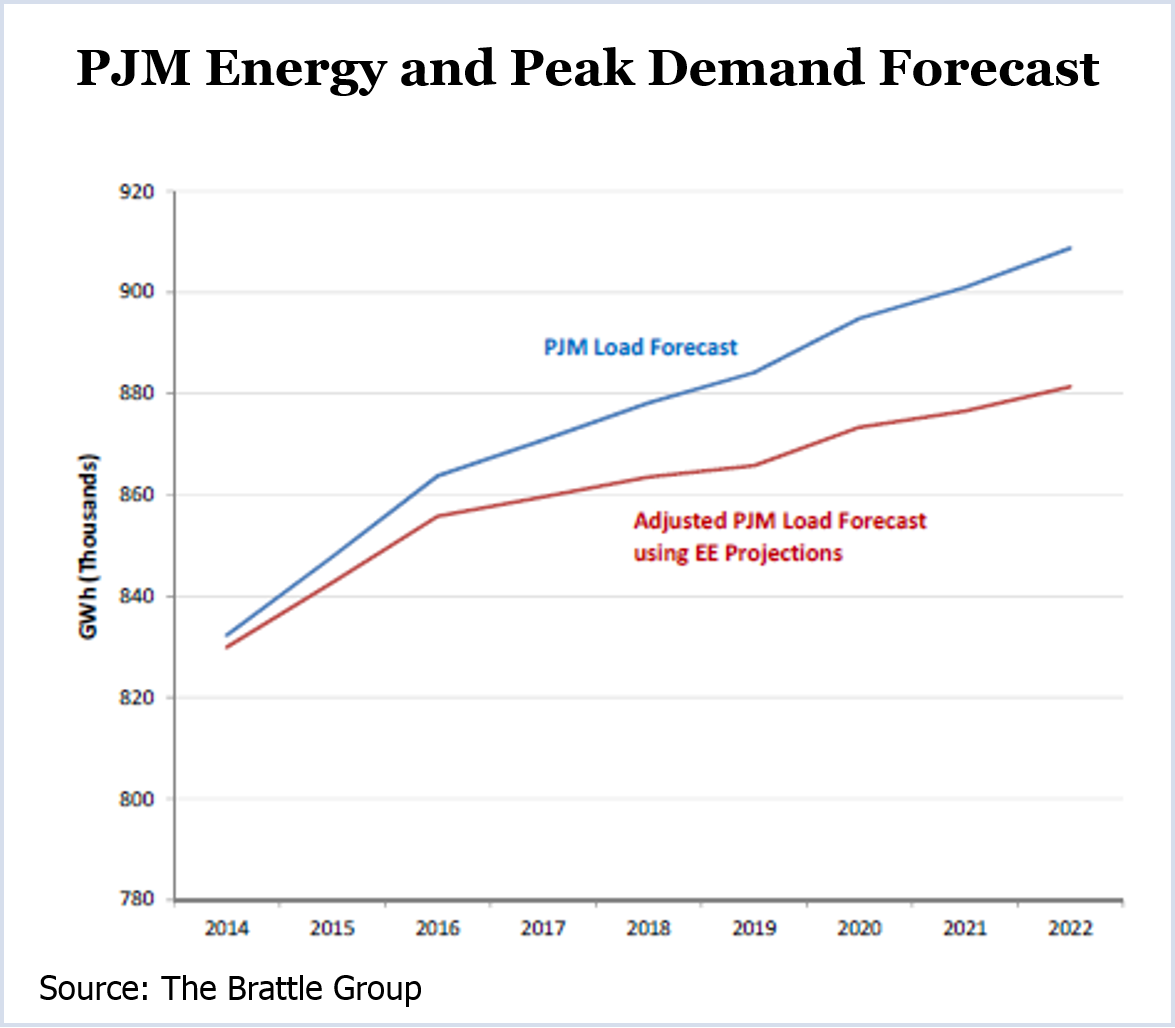
Unlike ISO-NE and NYISO, PJM’s energy forecasts do not account for all energy efficiency projected to come online during the forecast period, according to the report, which was commissioned by the Sustainable FERC Project, an initiative of the Natural Resources Defense Council and others.
Improved forecasts could reduce both environmental impacts and customer costs, the report said.
Including the missing energy efficiency would reduce PJM’s cumulative average growth rate for energy and peak demand to 0.8% from 1.1% through 2022, with a reduction in total customer costs of $433 million annually through 2017/18 and by $127 million annually beyond.
Short-run capacity reductions of $527 million annually are partially offset by $93 million in increased energy costs due to reduced reserve margins.
The projected cumulative GWh savings from new energy efficiency relative to 2013 will reach 11,213 GWh (1.3% of load) in 2017 and 27,245 GWh (3% of load) in 2022.
“In ISO New England (ISO-NE) and the New York ISO (NYISO), targeted efforts have been undertaken to capture the effects of existing and planned energy-efficiency programs that may be unaccounted for in the forecasting process,” the report said. “Such targeted efforts do not exist for the PJM Interconnection.”
PJM Capturing only Some Energy Efficiency
PJM’s current load forecast includes historical energy efficiency embedded in econometric forecasts and supply-side energy efficiency that clears in capacity auctions.
“However, this approach does not capture the existing EE that did not bid into/clear in the [auctions] or any new/incremental EE programs predicted beyond the three-year forward capacity market window,” Brattle said. “Both ISO-NE and NYISO have addressed these issues in their load-forecasting processes to account for the full effects of the EE investments and produce a more accurate load forecast.”
PJM Responds
PJM spokesman Ray Dotter said the RTO has “a solid record for including energy efficiency” in its markets and load forecasts, noting that the last Base Residual Action cleared 1,339 MW of energy efficiency.
“The reduction in the load forecast that Brattle predicts for 2017, 1.1%, is well within the margin of error expected over a three-year forecast,” Dotter said. “The annual capacity market also procures 2.5% less capacity than the load forecast indicates to allow for corrections to the expected demand closer to the actual delivery year. The ‘hold back’ provides opportunities for energy efficiency in the shorter-term auctions.”
Still, Dotter said PJM is considering improvements in the way it incorporates efficiency into its forecasts. Dotter said the RTO will begin discussing potential changes and the impact of the D.C. Circuit Court decision on demand response with stakeholders soon. (See related story, Appeals Court Snuffs Hope for FERC DR Jurisdiction.)
Study Methodology
Brattle based the study on publicly available filings for each of the 20 utility zones in PJM: utility and state integrated resource plans and demand side management filings, and Energy Information Administration Form 861.
The consultants applied their methodology to publicly available data for New England and found that it identified about half the missing energy efficiency identified by ISO-NE. “This implies that our projection approach is likely to underestimate the level of new EE that will be implemented in the forecast period. Therefore, our results are most likely on the conservative side.”
Stakeholder Criticism
The Sustainable FERC Project is a coalition of clean energy advocates and other public interest organizations “focused on breaking down federal regulatory barriers to the grid integration of renewable energy demand-side resources.”
The Brattle report provides support for stakeholders representing PJM load, who complain that the RTO’s load forecasts have been too high since at least the recession.
One of the authors of the Brattle report, Kathleen Spees, Ph.D., also helped lead the consulting firm’s review of PJM’s Variable Resource Requirement curve parameters, which Brattle performed for the RTO as part of the recent Triennial Review.
Brattle’s work on the 2014 Triennial Review did not include an analysis of PJM’s load forecasting. In its 2011 review, Brattle recommended PJM “increase the transparency and stakeholder understanding of the load forecasting process,” noting that it had been the subject of stakeholder complaints.

